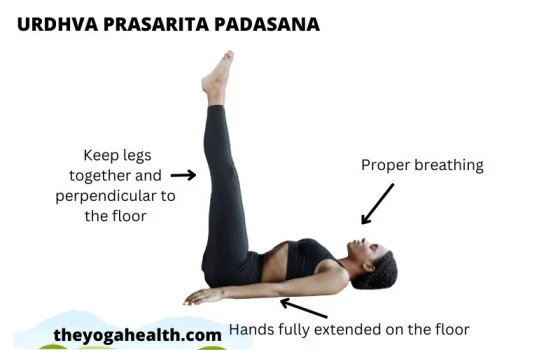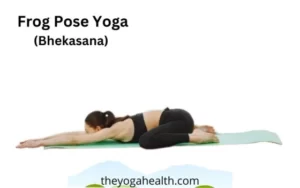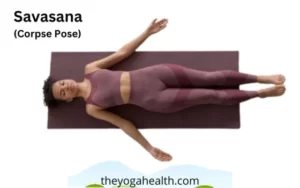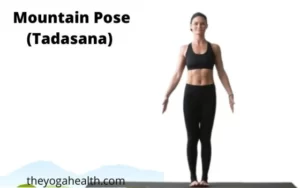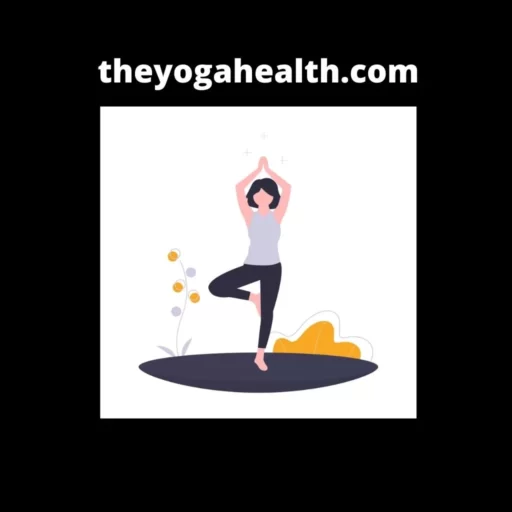Urdhva Prasarita Padasana (Upward Extended Feet Pose) mainly targets the abdominal and hip muscles. In this asana, legs are moved in an upward direction. The dynamic upward movement of the legs prepares and strengthens the muscles of the core, abdominal, lower back, pelvic and hips, etc.
This asana helps in gaining strength for the beginners and gradually person can move to variations of this pose as well (Upward Extended Feet Pose variations)
Table of Contents
What is Urdhva Prasarita Padasana
The name Urdhva Prasarita Padasana explains the purpose of the asana, it consists of three parts where ‘Urdhva’ means ‘Upward’, ‘Prasarity’ means ‘Extended’ and ‘Pada’ means feet. This asana is having multiple benefits and is comparatively have a very lower risk because it is completely done lying flat on the floor.
Basic details:
| Sanskrit Name | Urdhva Prasarita Padasana |
| English Name | Upward Extended Feet Pose |
| Difficulty Level | Beginner |
| Position | Supine |
To whom this asana benefits
This pose particularly benefits joggers and runners, as they can do warm-up practice with this asana. Because this asana engages the muscles of the core and abdomen in a very effective mode, variations of this asana can be included in other Yoga sequences as well like:
- Vinyasa Yoga
- Power Yoga
- Yoga sequences for athletes
- Yoga sequences for aerobics
- 10 minute Yoga sequences for those who have less time for a workout, etc
This asana helps to maximize energy in our body and thus can also be included in various flow yoga sequences.
This pose is also considered a warm-up yoga asana to prepare the body for variations and for more advanced Yoga poses / Yoga flows.
Urdhva Prasarita Padasana Benefits following muscles:
Thus can be included in yoga movements with the resultant muscle focus:
- Abdominal muscles
- Lower Back muscles
- Core muscles
- Feet and Ankles muscles
- Hamstring muscles
- Hip muscles
- Pelvic muscles
How to do Urdhva Prasarita Padasana
The below-mentioned yoga poses show in multiple ways to do this asana depending upon the focus of your yoga training and on the strength and ability of the person.
First Variation:
- Start the practice lying down on your back, and stretch your legs keeping the toes flexed and tightening the knees. Place your hands by the side of your legs. This stimulates the entire length of the legs and prepares you for the asana (pose), which gets the most out of the asana.
- Exhale, move the arms over the head, and stretch them out straight on the floor. keep the palms shoulders distance apart. take two breaths.
- Exhale, raise the legs up through 30 degrees, keeping the legs together, and hold the position for 15 to 20 seconds with normal breathing.
- Exhale, move the legs up to 60 degrees still keeping the feet together, and hold for 15 to 20 seconds with normal breathing.
- Again exhale, move the legs higher till they are perpendicular and lift both the legs 90 degrees to the floor, keeping the legs together, hold it for 30 to 60 seconds with normal breathing.
- Now exhale, lower the legs slowly to the floor and relax for some time.
You can repeat 3 or 4 times from position 2 to 6
You can see the lower abdomen become more and more excited as you switch between positions. The 30-degree position would be the most difficult to perform as there are much more core activities involved in it.
Inhale and as you exhale, bring your arms beside your legs. Relax your body and take a rest with your knees bent with your arms beside your legs.
If you find it difficult to do the three positions in one stretch, then you can also do them in 3 steps taking a rest in between.
Second Variation:
- Start the practice lying down on your back on the floor and stretch your legs keeping the toes flexed.
- Inhale and take your arms above your head and stretch them out straight on the floor. Keep the palms shoulder-distance apart.
- Exhale, lengthen the neck. Inhale and lift both the legs 90 degrees from the floor, meanwhile keeping the legs together. Stay in this position for 20- 30 seconds, normal breathing.
- Exhale, lower your legs to 60 degrees, and still keeping the feet together. Stay in this position for about 15 – 20 seconds, with normal breathing.
- Exhale again and lower the legs further to 30 degrees from the floor, keeping the legs intact. Stay here for 15- 20 seconds of normal breathing.
Breathing During The Pose
When practicing this asana, it’s important to pay attention to your breath. By coordinating your breath with the movements of the pose, you can enhance its effects and experience a deeper sense of relaxation and focus.
Now, let’s explore the breathing technique for this asana. As you start, the pose take a slow and deep breath in through your nose. Feel the air filling your lungs and expanding your abdomen, chest, and ribs.
Exhale through your nostrils gently and steadily once you’ve taken a complete breath in. Visualize releasing any tension or stress from your body as you breathe out. Allow your abdomen to gently contract and feel the breath leaving your body.
Continue this pattern of deep inhalations and slow exhalations throughout the pose.
Each breath should be taken slowly, giving you time to inhale and expel completely.
Pay attention to how your breath feels as it enters and exits your body.
Maintain a smooth and steady breathing throughout the asana. Avoid any forceful or strained breathing. Let your breath flow naturally, supporting your body as you hold the pose.
You can have a sense of calmness and relaxation after doing this breathing technique.
Your parasympathetic nervous system is activated by deep breathing, which lowers tension and fosters tranquility.
When you’re ready to release the pose, slowly lower your legs back down to the ground. Rest for a moment in a relaxed position and assess your practice’s results.
Practicing this asana with this breathing technique can enhance your focus, increase your lung capacity, and bring a greater sense of well-being to your body and mind.
Urdhva Prasarita Padasana Benefits:
In this asana the legs move in such a way that keeps many muscles engaged, which brings with it numerous benefits. These are explained below:
1. Stretch and strength
The active movement of the hip stretches the muscles of the legs, abdomen, pelvis, in the upward and downward movement of the legs.
These muscles strengthen the core and abdominal muscles keeping the lower back muscles active and flexible. Strong core muscles act as solid support for the lower back and hips.
2. Posture and Toning
In this pose various group of muscles is stretched and contracted with each movement, the active use of the shoulders and chest strengthen the sides of the upper body.
Frequent stretching helps in toning and strengthening the posture of the back. It especially benefits the person with a hunchback or those who are obese.
3. Stimulation and Metabolism
It strengthens the inner muscles that are around the abdominal organs.
The active movement of the abdominal muscles which stretches and contracts regularly helps in the stimulation of the internal organs of the body.
This in return hugely helps in improving digestion and assimilation of food. Additionally, it aids in reducing stomach-related symptoms like bloating, gastritis, and flatulence.
4. Energy and Circulation
The movement of the legs in a particular direction increases the heart rate.
The blood is properly oxygenated, which raises the body’s energy levels in addition to the higher heart rate.
The increasing activity of the muscles of the body with more oxygen keeps the body fully energized with proper circulation of the blood flow and throwing wastes of the body like carbon dioxide and lactic acid.
The body and mind are liberated from sluggishness, lethargy, and dullness with high levels of vitality and healthy blood circulation.
5. Other benefits
It can be included in the various yoga sequences to build stronger legs and core muscles.
This yoga asana can also be included in postnatal yoga to strengthen the pelvic floor muscles few months after delivery.
But it is always advised that practice should be done under the guidance of an experienced Yoga teacher, to avoid any injury or complications.
Urdhva Padasana Precautions
It is very important to do all yoga poses keeping in the mind the age, location, body conditions, injuries, and diseases so that no harm is caused to the person practicing it.
1. In case of Injury and Surgery
This asana stretches and contracts the hip area which further puts pressure on the lower back muscles.
Hence any person suffering from lower back issues due to any injury or severe back pain should avoid the leg raise movements.
Persons should also skip if they are recovering from any abdominal surgery, a slipped disc or anything that is contraindicated for the lumbar spine, hip flexors, pelvis, and hips.
Injury to the rib cage, shoulders, upper body is also contraindicated, and hence best to avoid this asana.
2. Kids and old age person
Upward Extended Feet Pose for kids or old age persons should be done with caution. A very rapid heartbeat is not safe, and the chances of this happening in this variation are high.
The rapid movement of the legs and holding them at different degrees from the ground can also lead to breathlessness, hence, not safe for everybody, specifically for kids and senior citizens who may find breathing a challenge.
The rapid movements of the legs with the active hip flexors put pressure on the lower back, so care should be taken. The tender hip joints and lumbar vertebrae will not be able to take the pressure.
3. Pregnant women
As pregnant women are in such a situation that rapid movement of any body parts particularly related to abdominal areas can do harm to them or to the baby in the womb.
Therefore, it is always advisable to avoid rapid movement of this asana during pregnancy. However under expert guidance asana with slow gentle movement during the pregnancy can be done, if there is no pain or discomfort.
Variations
Urdhva Padasana is also a base pose for (Pada Sanchalanasana) Cycling Pose.
As persons have different abilities depending upon various factors, a given yoga pose may be easy for a particular person but hard for another.
In such a case, a person can do variations to further challenge his muscles, whenever they find a specific yoga pose easy to perform.
This pose variations can help you to grow and build further confidence in your yoga practice no matter what your starting ability levels were.
Conclusion For Urdhva Prasarita Padasana:
Urdhva Prasarita Padasana (Upward Extended Foot Pose) is a particularly beneficial asana for reducing fat around the abdomen. It gives power and strength to the lumbar region of the back, it also tones the abdominal organs, and relieves those suffering from gastric trouble and flatulence.
FAQs:
Q1. What is Urdhva Prasarita Padasana?
Ans. This is a standing yoga pose that involves extending the legs upward while lying on your back.
The name itself translates to “Upward Extended Foot Pose” in English.
This pose is renowned for its capacity to strengthen the core, enhance digestion, and increase hip and hamstring flexibility.
Q2. How do I perform Urdhva Padasana?
Ans. Follow these instructions to perform this asana:
Lie on your back on the yoga mat and extend your legs in front of you.
Your palms should be facing down and your arms should be at your sides.
Take a deep breath in while contracting your abs.
Lift your legs slowly off the floor while keeping them close together as you exhale.
Continue raising your legs until they meet your body at a 90-degree angle.
Hold this posture for a few breaths, concentrating on keeping your balance and stability.
After exhaling, gently reposition your legs to the beginning position.
For the specified number of repetitions, repeat the stance.
Q3. What are the benefits of Urdhva Padasana?
Ans. This asana offers a wide range of benefits, including:
· Strengthening the abdominal muscles and core.
· Improving digestion and aiding in detoxification.
· Hamstrings, hips, and lower back stretch.
· Enhancing blood circulation in the legs.
· It calms the mind and reduce stress and anxiety.
· Improving overall posture and body alignment.
Q4. Are there any variations of Urdhva Padasana?
Ans. Yes, there are variations of this asana that can be adapted based on your comfort and skill level.
Typical variants include: Bent-Knee Variation: To maintain the same hip-width distance, you can alternate between completely extending your legs and bending your knees to place your feet soles on the ground.
Wall Support Variation: If you’re a beginner or require additional support, you can practice this pose with your back against a wall, ensuring proper alignment and balance.
Strap Variation: For individuals with limited flexibility, a strap can be used to loop around the feet and provide assistance in lifting the legs.
Q5. How often should I practice Urdhva Padasana?
Ans. The frequency of practicing this asana may vary depending on your level of experience and fitness goals.
For best results, it is typically advised to include this pose in your normal yoga program at least two to three times each week.
Remember to allow for rest and recovery between practice sessions.
Q6. What precautions should I take while practicing Urdhva Padasana?
Ans. When practicing this asana, keep the following precautions in mind:
Warm up your body with gentle stretches before attempting the pose.
Avoid jerky movements and maintain a slow, controlled pace throughout.
Engage your core muscles to support your lower back and prevent strain.
If you experience pain or discomfort, release the pose and consult a professional.
Now that you have a better understanding of this asana, you can confidently incorporate this pose into your yoga practice.
Remember to practice with mindfulness, listen to your body, and enjoy the journey of exploration and growth on your mat.
Q7. Can anyone practice Urdhva Padasana?
Ans. This asana is generally safe for most people to practice.
However, it’s important to listen to your body and avoid any strain or discomfort.
Individuals with the following conditions should consult with a qualified yoga instructor or healthcare professional before attempting this pose:
Recent abdominal surgery or injury
High blood pressure
Hernia
Pregnancy
Share your experience of performing this asana and if you have any questions regarding this pose you can ask in the comments section below.


